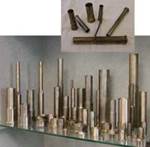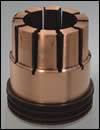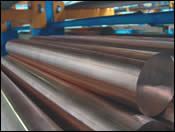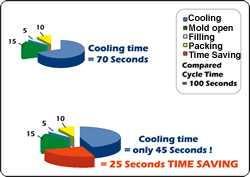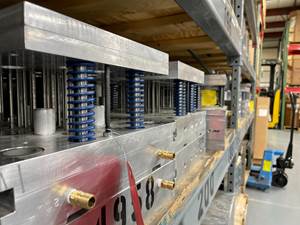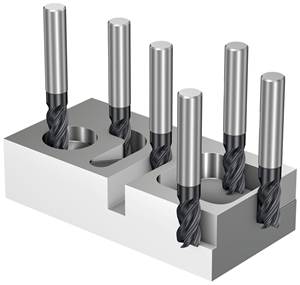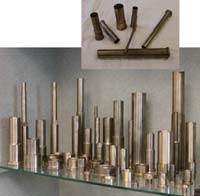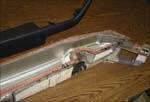Breaking Down the Cost of High Conductivity Copper Alloys in Moldmaking
Improving productivity with high conductivity copper alloys.
Moldmakers have been reluctant until now to use high conductivity copper alloys in their molds due to the perceived cost of copper-based alloys compared with conventional tool steels.
A high conductivity copper alloy is—within the context of this article—a copper-based material that through a combination of alloying and manufacturing techniques, retains the higher thermal conductivity that is inherent in copper, but with a degree of hardness that allows it to be used in the machined condition within a production environment.
Benefits
Some of the reasons to consider the use of copper alloys in plastic injection molds include:
- Cycle time can be reduced by at least 20 percent (some users report reductions of up to 80 percent), resulting from the significantly faster cooling rates achieved with high conductivity copper alloys.
- Productivity can be increased by at least 25 percent, with some users in the automobile headlight production industry reporting up to a 500 percent production increase simply because a reduced cycle time means more components can be made per shift.
- Part warpage can be greatly reduced as, with the improved cooling, the molded component spends less time at an elevated temperature, thus the number and severity of “hot spots” within the mold are reduced and part quality is greatly improved.
- Less warpage means more constant part quality, shot after shot.
- Due to the superior thermal transfer characteristics of high conductivity copper alloys, (typically five to 10 times better than steel), heat can be moved away from sensitive areas of the mold at such a rate that the need for complex cooling channels in the immediate location of the molded component is reduced, or eliminated altogether.
- Because the number of cooling channels required in the tool is less, the machining costs of the molds can be greatly reduced—up to four times less than that of a comparable cooling rate on a steel mold.
Specific advantages of high conductivity copper alloys include:
Diffusivity
High conductivity copper alloys absorb the heat wave in a mold when a plastic part is injected. The initial absorption of the heat wave is a key factor. Heat removal in the backstage with the cooling system leaves plenty of time to do it. This is where high conductivity copper alloys really shine—absorbing the first heat wave, shot after shot.
Polishability
The excellent polishing ability of high conductivity copper alloys has been proven when used in contact lens packaging manufacture, which requires the lenses to be transparent so they can be checked through the packaging. Such high quality plastic packaging is achieved with high conductivity copper alloy inserts highly polished.
The polishing time of such inserts has proven to be four times faster than steel inserts, and the cycle time to be reduced by 57 percent.
Coatings
In order to increase wear resistance, the high conductivity copper alloys can be very easily coated with electroless nickel, hard chrome or even PVD (physical vapor deposition) or CVD (chemical vapor deposition) coatings.
Electroless nickel allows the coating to penetrate into each and every hole with a constant coating thickness, which is not the case with a galvanic process, such as hard chrome plating. Hardness of up to 60 to 70 HRC can be achieved.
For easier plastic part removal when demolding, electroless nickel can be combined with Teflon (PTFE) or boron nitride. Such mold parts have a surface that feels as slippery as soap when coated with PTFE or boron nitride electroless nickel, which results in molded plastic parts that will not stick and that will demold very easily.
Limitations
When using high conductivity copper alloys within a mold, in order to prevent stress relieving or annealing of the alloy (and thus maintain the hardness characteristics of the material), the mold should be configured such that prolonged exposure to elevated temperatures above 900oF would be avoided.
Applications
Following are a few of the applications for which high conductivity copper alloys are a good material choice to consider:
- Plastic injection molds, cores and cavities, core pins and chill plates.
- Dies used in the extrusion of complex plastic profiles and shapes. The use of high conductivity copper alloys here results in productivity gains from their rapid heat transfer and dimensional stability.
- Blow molds for the production of bottles. High conductivity cop-per alloy inserts in the mold—par-ticularly at the base of the bottle and around the neck—will result in the optimum manufacturing productivity and component quality.
- Injection nozzles. When high conductivity copper alloys are used, an even temperature is maintained that will result in a far simpler overall control system due to the rapid heat transfer time and reduced energy costs.
| PRODUCTION REQUIRED : 100,000 UNITS INJECTION MOLDING COST : $203 - / hour |
|||
| Cycle Time (sec.) | Production hours for 100,000 units | Injection molding cost ($) | |
| Steel Mold | 100 | 2,778 | 564,584 |
| Ampcoloy 940 | 75 | 2,083 | 423,334 |
| Savings | 25 | 695 | 141,250 |
| Example of cost advantage gained by using high conductivity copper alloy cores. | |||
Product-Specific Examples
Plastic Bin Production
Plastic bin manufacturers are using molds containing high conductivity copper alloys and depending on the level of desired performance, some manufacturers use beryllium copper alloys for the cores and cavities. However, where work shop practices exclude beryllium-containing alloys from being used, a beryllium-free alloy is the material of choice.
Plastic Caps Production
Plastic mineral water bottle closures, in the form of plastic caps are produced with considerable success using high conductivity copper alloys cores and cavities. Oftentimes 0.5 percent BeCuCo alloys are used—dependent upon which polymer is being molded—with an electroless nickel coating.
Again, the sensitivity toward using beryllium alloys has resulted in the development of highly effective, beryllium-free alternatives.
Automotive Production
The automobile industry has introduced aluminium bronze inserts into their steel molds for the production of bumpers, where others even use complete high conductivity copper alloy cores for their bumpers production.
Dashboards for automobiles are also produced with molds containing aluminium bronze inserts, thus increasing the heat conductivity by three times compared to the steel used in production.
Conclusion
In order for today’s molds shops to maintain the capacity of the American molding sector and compete against low-cost manufacturing areas of the world, it is important to consider the use of high conductivity copper alloys in your plastic injection mold manufacturing. High conductivity copper alloys will enable shops to offer tooling that gives greater productivity and cost savings with enhanced quality.
![]()
Related Content
Technology Review and Sourcing Guide 2025: Mold Materials
Building a high-quality mold begins and ends with the proper selection of appropriate mold materials. Tool steel, aluminum, copper and alloys are a just a few you can find in this exclusive, online-only content that includes a supplier list for mold materials.
Read MoreFive Benefits of Aluminum Tooling
Aluminum molds are worth a second look as a viable means to swiftly and cost-effectively get products to market.
Read MoreHow to Machine Aluminum Molds to Enhance Efficiency and Quality
Ways to optimize the machining process to fully leverage the benefits of an aluminum mold.
Read MoreDebunking the Myths: Aluminum Tooling Facts vs. Fiction
Advancements in aluminum alloys, machining and design debunk myths, proving aluminum molds deliver durable, precise, high-quality and cost-effective production solutions.
Read MoreRead Next
Design Criteria for Using Copper Alloys in Molds
The extent of copper alloy use, the success of its application and the life of the components are determined by the selected alloy in combination with the design of the application.
Read MoreLessons in the Use of Electroformed Nickel Tools
Solutions to problems moldmakers face with today’s styling requirements in the instrument panel tooling industry.
Read MoreMaking the Most of High-Performance Mold Materials
Understanding high conductivity alloys and optimizing their use can help you build better molds.
Read More
